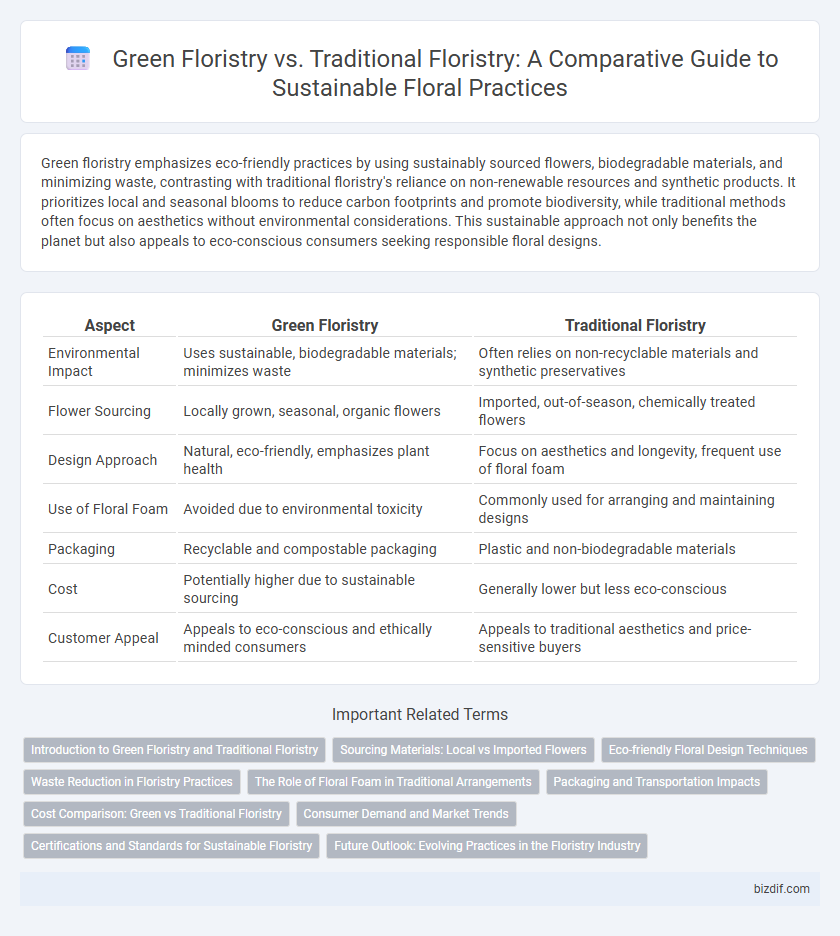Green floristry emphasizes eco-friendly practices by using sustainably sourced flowers, biodegradable materials, and minimizing waste, contrasting with traditional floristry's reliance on non-renewable resources and synthetic products. It prioritizes local and seasonal blooms to reduce carbon footprints and promote biodiversity, while traditional methods often focus on aesthetics without environmental considerations. This sustainable approach not only benefits the planet but also appeals to eco-conscious consumers seeking responsible floral designs.
Table of Comparison
| Aspect | Green Floristry | Traditional Floristry |
|---|---|---|
| Environmental Impact | Uses sustainable, biodegradable materials; minimizes waste | Often relies on non-recyclable materials and synthetic preservatives |
| Flower Sourcing | Locally grown, seasonal, organic flowers | Imported, out-of-season, chemically treated flowers |
| Design Approach | Natural, eco-friendly, emphasizes plant health | Focus on aesthetics and longevity, frequent use of floral foam |
| Use of Floral Foam | Avoided due to environmental toxicity | Commonly used for arranging and maintaining designs |
| Packaging | Recyclable and compostable packaging | Plastic and non-biodegradable materials |
| Cost | Potentially higher due to sustainable sourcing | Generally lower but less eco-conscious |
| Customer Appeal | Appeals to eco-conscious and ethically minded consumers | Appeals to traditional aesthetics and price-sensitive buyers |
Introduction to Green Floristry and Traditional Floristry
Green floristry emphasizes sustainable practices by using locally sourced, seasonal flowers and biodegradable materials to minimize environmental impact. Traditional floristry typically relies on imported flowers, floral foams, and synthetic accessories, prioritizing aesthetics and availability over eco-friendliness. The shift towards green floristry reflects growing consumer demand for environmentally responsible floral designs and practices.
Sourcing Materials: Local vs Imported Flowers
Green floristry prioritizes sourcing local flowers, reducing carbon footprints and promoting sustainable farming practices, which supports regional ecosystems and economies. Traditional floristry often relies on imported flowers, increasing transportation emissions and the use of preservatives to maintain flower longevity during long shipping periods. Choosing local blooms enhances freshness, seasonality, and environmental responsibility compared to the reliance on exotic, imported varieties.
Eco-friendly Floral Design Techniques
Green floristry emphasizes sustainable practices such as using locally-sourced, seasonal flowers and biodegradable floral foam alternatives to minimize environmental impact. Traditional floristry often relies on non-recyclable materials and out-of-season imports, contributing to higher carbon emissions. Eco-friendly floral design techniques include composting plant waste, utilizing recycled packaging, and choosing native plants to promote biodiversity and reduce chemical usage.
Waste Reduction in Floristry Practices
Green floristry emphasizes sustainable waste reduction by using biodegradable materials, repurposing plant trimmings, and minimizing floral foam usage, significantly lowering environmental impact compared to traditional floristry. Traditional floristry often relies on non-recyclable floral foam, plastic wraps, and excessive packaging, which contribute to landfill waste and pollution. Adopting green floristry practices enhances resource efficiency and promotes eco-friendly floral arrangements.
The Role of Floral Foam in Traditional Arrangements
Floral foam, commonly used in traditional floristry, serves as a water-retaining medium that supports flower stems and prolongs the freshness of arrangements. Despite its effectiveness, floral foam poses significant environmental concerns due to its non-biodegradable and toxic properties, contributing to plastic pollution. Green floristry emphasizes sustainable alternatives such as natural moss, chicken wire, or reusable flower frogs that eliminate reliance on floral foam while maintaining structural integrity in eco-friendly designs.
Packaging and Transportation Impacts
Green floristry prioritizes sustainable packaging materials such as biodegradable wraps and recycled boxes, significantly reducing plastic waste compared to traditional floristry, which often relies on non-recyclable plastics. Transportation in green floristry emphasizes local sourcing and minimized delivery distances to lower carbon emissions, contrasting with traditional methods that sometimes involve long-distance shipping and higher fuel consumption. These practices make green floristry a more environmentally responsible choice by decreasing both packaging waste and transportation-related pollution.
Cost Comparison: Green vs Traditional Floristry
Green floristry often reduces overall costs by utilizing locally sourced, seasonal flowers and sustainable materials, minimizing transportation and waste expenses. Traditional floristry typically incurs higher costs due to imported blooms, synthetic accessories, and extensive packaging requirements. This cost-efficient approach in green floristry appeals to both environmentally conscious consumers and budget-sensitive clients.
Consumer Demand and Market Trends
Consumer demand for green floristry is rapidly increasing as eco-conscious buyers prioritize sustainable practices and biodegradable materials, leading to a significant shift in market trends. Traditional floristry, reliant on non-sustainable sourcing and synthetic preservatives, faces declining appeal among environmentally aware customers. Market data reveals a surge in growth for green floristry sectors, driven by rising awareness of climate impact and preference for locally sourced, seasonal blooms.
Certifications and Standards for Sustainable Floristry
Green floristry prioritizes certifications such as Fair Trade, Rainforest Alliance, and Florverde to guarantee environmentally responsible growing practices and ethical labor standards. Traditional floristry often lacks standardized sustainability certifications, relying instead on conventional supply chains with limited transparency. Emphasizing adherence to GlobalG.A.P. and LEED standards, green floristry ensures reduced carbon footprints and ecological impact through sustainable sourcing and waste management.
Future Outlook: Evolving Practices in the Floristry Industry
Green floristry emphasizes sustainable sourcing, biodegradable materials, and eco-friendly floral design techniques, positioning itself as a leading trend in the future of the floristry industry. Traditional floristry often relies on non-renewable resources and synthetic preservatives, which face increasing scrutiny due to environmental concerns. Innovations such as locally grown flowers, zero-waste arrangements, and organic fertilizers are reshaping floristry practices toward a more environmentally responsible and economically viable future.
Green Floristry vs Traditional Floristry Infographic

 bizdif.com
bizdif.com